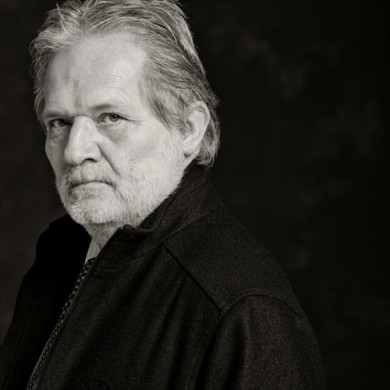Significant modernist works highlight Eötvös program with New World

Peter Eotvos conducted the New World Symphony’s “Sounds of the Times” program Saturday night. Photo: Marco Borggreve
Miami’s new-music faithful filled New World Center Saturday night, staying through the end of one of the New World Symphony’s most radical and challenging Sounds of the Times programs yet. “Modern Europe” brought two local premieres to Miami Beach: Hungarian composer/conductor Peter Eötvös’ da capo for cimbalom and ensemble, and the long overdue Punkte from 1952 by Eötvös’ mentor, Karlheinz Stockhausen.
A legend in European new music but lesser known in the US, Eötvös composes in the German and French “spectralist” style, using components of sound revealed by computers for developing musical structures. Not limiting himself to twelve notes, Eötvös instead explores the microtonal spaces between to create a vast musical universe. There are no soloists in Eötvös’s music, but the ensemble virtuosity makes each player essential.
Speaking through a German translator, Eötvös called da capo his newest but oldest work. At the request of the commissioner, Salzburg Mozarteum Foundation, Eötvös identified sketches by Mozart from their archives that he could translate into his own music.
Crotales signaled nine times, announcing the entrance of a Mozart fragment before, launching into Eötvös’ frenetic, colorful patterns. Playing the cimbalom—a Hungarian instrument similar to a large hammered dulcimer—Chester Englander reliably rendered Eötvös’ occasional melodic ideas. Oddly, Eötvös eschews the cimbalom’s dazzling polyphonic capabilities, only occasionally sustaining its haunting colors throughout the orchestra.
At times the Mozart fragment emerged recognizably, jolting the listener out of Eötvös’ sound world, and the extreme stylistic contrasts worked against a unified musical statement. Nonetheless, da capo is a brilliant, demanding work, and NWS gave it a nuanced premiere.
Eötvös’ Chinese Opera from 1986 is a pillar within his repertoire. Written for Pierre Boulez’s modernist Ensemble Intercontemporain, of which Eötvös was the first music director, Chinese Opera features two mirrored chamber orchestras and a third amplified ensemble including harps, tuba, and synthesizer.
Eötvös explained that the very loud Prelude reimagines the huge noise Chinese operas made announcing themselves to a new city. In the First Scene, annunciatory, motoric percussion echoed antiphonally across the stage, in a trajectory from noisy motion to lulling washes of sound. Exquisitely guided by Eötvös, the musicians clearly balanced and colored each motive within the multilayered texture.
In the Second Scene, stunning amplified percussion and tuba breath noise introduced perpetually falling lines and microtonal timbres in winds and strings, creating a placid atmosphere. A surprising crescendo and its aftermath suggested a giant, wheezing machine running down.
The Third Scene’s huge, tolling chords generated sound like a tremendous organ. Unequal lengths and shifting colors gradually broke up into individual parts and then reformed, punctuated by portentous percussion, dueling harps, and unearthly synthesizer tones for a bravura end to this major and important work.
Karlheinz Stockhausen’s Punkte from 1952 illustrated how mid-century modernism still informs today’s vanguard. The work is in moment form: a succession of musical events separated by rests, emphasizing each’s importance.
NWS brought the 24-year-old Stockhausen’s work to vivid life, with silences dividing evolving fusions of color, sometimes bridged by solo brass or winds. Challenging in its lack of melody and massive 30-minute length, Punkte demands great concentration from performers. Guided by Eötvös’ clear cuing and vision from the podium, the musicians’ sustained commitment and energy for this work spoke deeply.
[Ed. note: An earlier version of this review stated that Stockhausen’s Punkte was being heard in its U.S. premiere. That information, contained in the New World Symphony program book, was in error. Punkte was given its U.S. premiere in 1971 by the Boston Symphony Orchestra, conducted by Michael Tilson Thomas.]
Posted in Performances
One Response to “Significant modernist works highlight Eötvös program with New World”
Leave a Comment
Sun Apr 5, 2015
at 3:53 pm
1 Comment
Posted Apr 08, 2015 at 8:13 am by ivor morgan
There are lots of sounds and musical ideas in Punkte that any concert-goer would immediately recognize in this fascinating music. I would recommend the CD of this work to any music lover who is prepared to listen to it over and over again, ‘absorbing’ the music, so to speak and at each listening being surprised and elated at finding yet another musical relationship of notes and themes.
As mentioned above, some of the music seems almost familiar – there is a powerful unison statement of five chords which temporarily halt the proceedings, aggressive motifs that demand our attention, calm introspective moments which invite our concentration: a lot more initially fascinates the listener by the sheer invention of new sounds and orchestral colours. Listening to Punkte for me, is a continual voyage of musical discovery as my brain recognises yet another connection – two oboes sounding two chords which seem to reappear minutes later after waiting patiently to do so: a long held flute note that seems to continue endlessly – acting as a figure of unity, rough and ready short melodies on brass which unrefusingly intent on being heard.
Indeed, several clear melodies can be heard at several points – a three-note motif immediately at the beginning on low woodwind (bassoons) and twenty seconds later a four note motif on strings – three low notes followed by a high staccato one. This note is the first ‘isolated’ single sound: it is tempting to think that single massive chords – one delirious – are an expansion of this and whether or not a development can be traced of each of the musical ‘blocks’ heard in the first twenty seconds of the work.
As each of us develops our own perceptions of a work and how we ‘make sense’ of it, the listener will find endless musical enjoyment – and a deeper understanding of Stockhausen’s genius – as he gets to know more and more of this fascinating and enjoyable work. I. Morgan